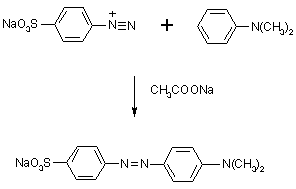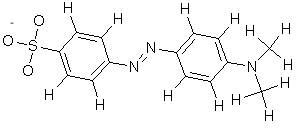| Vocabulary | |
azo compound diazonium salt  diazotization  indicator  pH strong acid  titration  weak base 
|
Chemists use methyl orange as an indicator in the titration of weak bases with strong acids. It changes from red (at pH 3.1) to orange-yellow (at pH 4.4):
pH-related color changes result from changes in the way electrons are confined in a molecule when hydrogen ions are attached or detached. Here is the structure of methyl orange in acidic solution:
|
In the basic form of methyl orange, a hydrogen ion is lost from the -NN- bridge between the rings, and the electrons formerly used to bind the hydrogen neutralize the positive charge on the terminal nitrogen, so that it is no longer able to pi-bond. Solutions of the methyl orange appear yellow in alkaline solution [2].
|
How is methyl orange made?
Methyl orange is synthesized by reaction of sulfanilic acid, sodium nitrite, and dimethylaniline. First, sulfanilic acid is dissolved in dilute aqueous acid. Sodium nitrite is added to produce a diazonium salt
This reaction is called diazotization and it is extremely useful in organic synthesis. The nitrous acid provides NO+ which replaces a hydrogen on the -NH3+ group to produce -NH2NO+ and water; a second water is eliminated to produce the -N2+ group.
The diazonium salt is then coupled with dimethylaniline. The coupling takes place in the opposite ("para") position from the -N(CH3)2 group:

The sodium acetate makes the solution weakly basic; the acetate ion accepts the hydrogen displaced from the dimethylaniline ring.
References and notes
- The Merck Index, 8th ed., Merck & Co., Rahway NJ, 1968. The index gives the following reference for details on the synthesis
of methyl orange:
L. Gattermann, Die Praxis des organischen Chemikers, 40th ed., de Gruyter & Co., Berlin, 1961, pp 260-261. - For more about the molecular basis of indicator color changes, see Water to Wine.

